

? | Home page | Tutorial | Recording




Before anything else, we need to prepare the recording session. We are not going to look for a melody, nor improvise or rehearse... we are going to properly record a song that we have already written. To avoid doing the same things over again each time I wish to record a song, I prepared a blank template which contains all the tracks and buses I need. I may naturally add or delete some elements if the template is not appropriate for the current project.
What does my template look like?
Track-wise:
- Rhythm guitar tracks (from 2 to 8 depending on the project)
- Solo guitar tracks (usually 2 tracks to make the sound thicker)
- Two bass tracks (one with the direct raw sound, and one with an amp simulation)
- Lead vocal tracks (usually one or two tracks, depends if I record it twice or not)
- Background vocals tracks (if the project demands it)
- Keyboard tracks (same thing, the number of virtual instruments will depend on the project, can be none, can be 5 or 6...)
Then we have drum tracks. There is one track per drum element. They are automatically created when I insert my virtual drum plugin:
- Kick drum
- Snare drum
- Low tom
- Medium tom
- High tom
- Hi-hat
- Crash cymbal
- Ride cymbal
- Splash cymbal
- Overhead microphone
- Room Ambiance microphone
- Piezzo microphone
- One MIDI track on which the drum score will be placed.
Bus-wise, I have one group for the guitars, one for the bass, one for the vocals, one for the drums, each of them is redirected towards the Master bus, which goes out throuh my studio monitors. It looks like this:

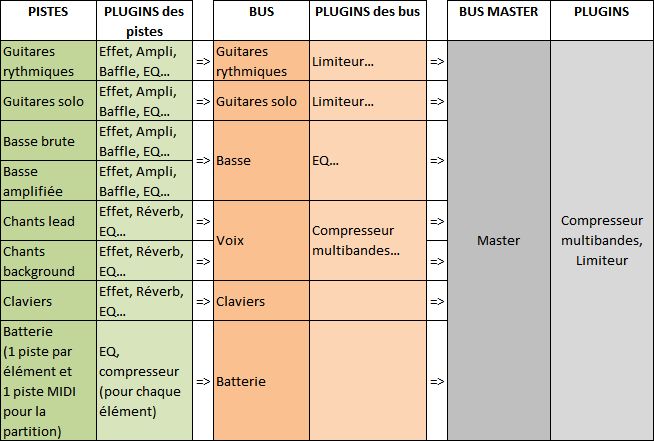





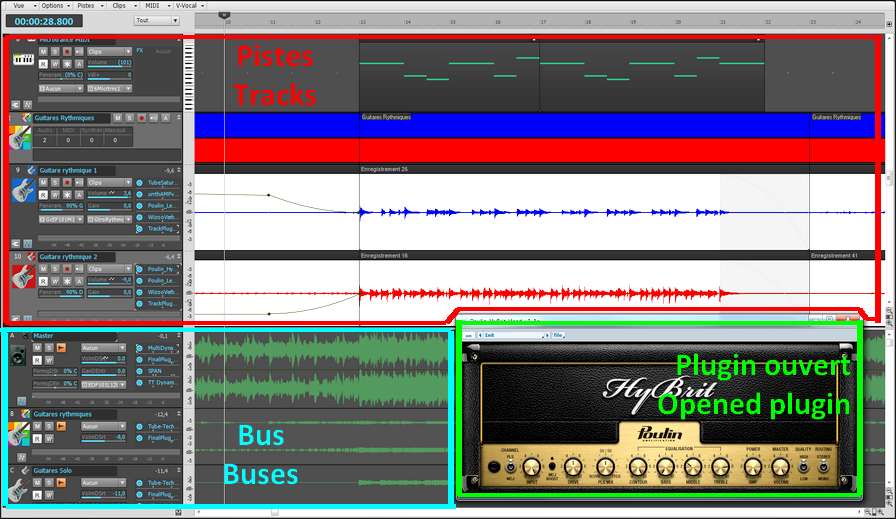


Recording an acoustic real drum kit is far from being easy, even for professional sound engineers. It a time-consuming process, it's frequent to spend several hours placing the microphones around the drum elements before you can actually record. But we are in a home studio, and we will have to deal with a software drum kit, based on midi files...
First of all, why start with the drums? The answer is simple, we will use drums as a metronome. The drums sound will guide us and help us follow the tempo. This will allow for an even recording and the song will not speed up or slow down unintentionally. Of course, variations can be interesting and bring some life to an otherwise mechanical tempo, but let's consider that a studio session seeks recording perfection, even though it's only a home studio.
I usually have no idea what my final drum track will sound like. Actually, I only adjust it when the rest of the song is finished. But I still need its metronome function to record all other instruments. Thus, I create a drum track which repeats itself over and over again, and I try to have this loop match what I am about to play (no punk rhythm to record a ballad). For instance, I'll use one of these patterns:
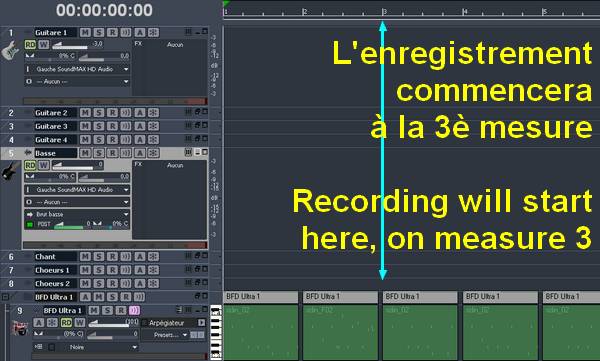

Let's not forget we are recording in a home studio, in an appartment and it is simply impossible to play with a good old 100-watt tube amplifier, without the neigbors calling the police. So we are going to have to record the guitars and the bass directly through the audio interface. No real amplifier, no microphones involved. The latter solution would be preferable, but on of the benefits of direct recording, coupled with amplifier simulators, is that you can always edit the sound later, without having to re-record. Just change the settings and you're done.
So now... bass or guitars first? There isn't one clear answer. Bass and drums are the foundation, the rhythm base of a song and everything else should rely on them. But other factors could also be taken into consideration: for instance, the person recording may be more comfortable with a guitar than a bass, and will rather play guitar first. Or maybe the song has a very important bass riff that compels you to record it first. In any case, you are the one who can decide. If you are uncertain, then the drum / bass duo is a safe bet. If this is in place, then the rest can easily be added.
Guitar or bass, the recording process will be the same. Plug your guitar into the pre-amp, the pre-amp is connected to the audio interface (or plug your guitar directly into the audio interface if using the interface's pre-amp), and set the recording level. This is very important! Before recording anything, check that you are not going to go beyond the maximum level (0 dB, zero decibel). In a home studio, you won't have a sound engineer besides you to make adjustments on the fly, while you are playing. You are the one to take precautions. How can you do that? Simple: try and adjust, it doesn't take long and will prevent you from making a perfect take, then realize the levels were too low or too high, forcing you to do it all over again.
Have a try: for a rhythm guitar for example, play the loudest parts and set the preamp and audio interface volume levels in such way that when you play the loudest, the recording level doesn't go beyond -6 dB. The absolute maximum that you should not reach or go beyond is zero dB. If you play in your try the same way you play during the actual recording, then you can be certain the recording level will be correct. If your average level is between -9 db and -6 dB, then your level is sufficient and you have a margin of error before clipping.
Clipping is the term used to indicate that you reach or go beyond 0 dB. Clipping is your enemy :-)
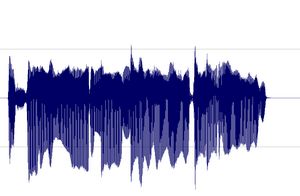
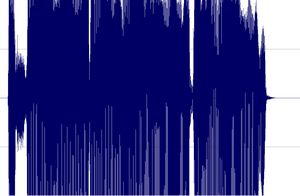
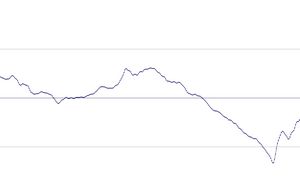
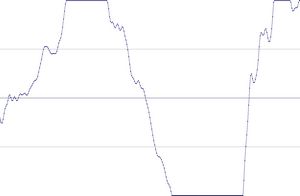

I prefer to record them last but there are no rules. If you prefer to record them first, then do so.
To record vocals, make sure the place is quiet, shut the door, tell the people who live with you to be quiet, and do not record while your neighbor is drilling holes through his kitchen walls! Also, turn off your monitors and use a headset instead to avoid recording the playback with your microphone.
Condenser or dynamic microphones?
Dynamic microphones are solid, they don' need a power source, they can take heavy acoustic pressure (like a kick drum or a saxophone) and they are not too expensive. They are also less sensitive to surrounding noises than condenser microphones. The cons are they lack clarity in the high range, which renders takes less clear and defined than with condenser microphones. They can be used with Jack or XLR plugs.
Condenser microphones are much more responsive and accurate. Their high sensitivity is double-edged, because they will capture any noise when recording. The fans of your PC are noisy? Chances are this noise will be recorded. Sound comes out of your headset? It will be recorded by your condenser microphone. Children are loudly playing outside? You might get that too. However, some condenser microphones are called "cardioid", or "hyper cardioid", and they only record what comes from a specific direction, ignoring (more or less) other sound sources from other directions. On the contrary, omnidirectional microphones record what comes from anywhere. Not ideal for a home studio. Condenser microphones are also more fragile (don't knock them) and must be powered through a "phantom power", whose standard is 48 volts. This kind of power is either present on your audio interface and can be turned on and off with a button, or it will require the use of an external phantom power source that you will then connect to your audio interface. You have to use 3-pin XLR plugs that carry the phantom power current. Finally, condenser microphones are usually rather expensive, some of them cost several thousand euros (or dollars, or pounds), but only professional studios or rich amateurs can afford those. On the plus side, the sound you get with a condenser microphone will have the best quality.
Be cautious though, a good dynamic microphone is worth better than a bad condenser microphone. No big secret here, for microphones like for anything else, very low prices are rarely synonymous with good quality.
A few known and renowned microphone brands: AKG, Milab, Neumann, Rode, Sennheiser, Shure...
Some pieces of advice: buy a microphone stand and a pop filter (you can also make one yourself with wire and a piece of tights from your wife / girlfriend / mother / daughter / neighbor). The stand will prevent you from manually holding your microphone and thus produce handling noises. As for the pop filter, it prevents the air to hit the microphone and produce unwanted blowing sounds when you pronounce some letters such as "p" or "b".
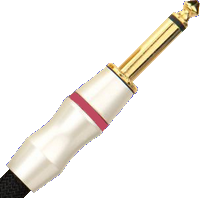
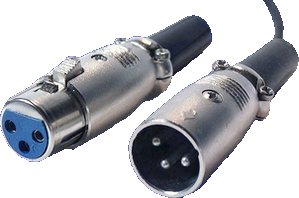
Jack plug (left) and XLR (right)
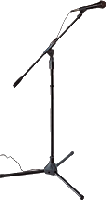


No need to go on and on forever, recording is rather easy. As long as you pay attention to your recording levels and take care over your takes, you should get a satisfying result, good enough to finalize the song

Messages page # 1 2 3 4 5 6 7 8 9 10 11 12 13 14 15 16 17 18 19 20 21 22 23 24 25 26 27 28 29 30 31 32 33 34 35

Mike key
le 03/10/2015 à 19h47
Bonjour !
Ben voilà ! Mon mail et une explication plus détaillée ! De mon côté, je suis arrivé sur la page anglaise sans chercher la version française !
Comme vous le savez, il n'y a pas beaucoup de vst pour Mac, alors Garageband me donne la majorité des amplis mais si je veux explorer vos propositions, je dois utiliser des manœuvres de contournement dans le gratos ! Ce que j'ai fait avec "Psycle".
C'est un logiciel open source assez puissant et versatile.
<a href="https://www.youtube.com/channel/UCNfVDlT7FBhDBeQdzFlR34g" target="_blank">Quelques exemples electro ici avec Psycle!</a>
En plus, j'ai découvert 2 autres amplis : Freeamp et Fa3full !
Pour une meilleure compréhension, je me dis que faire une capsule ne contenant que le but et rien d'autre serait un plus ! Soit l'objectif (reproduire le son d'un solo célèbre) et les moyens, soit l'illustration de la position des réglages (qui donne aussi le choix de l'ampli virtuel et où le télécharger) en évidence, puis le preset si nécessaire.
Il manque juste une vidéo de prof qui nous montre comment le faire avec la guitare !
Pour le reste, cette idée d'association logiciels et solos, moi je trouve ça accrocheur au max ! :-)

Mike Key
le 03/10/2015 à 06h50
Very interesting!
First the presets association with a famous solo is a very good idea but it don't work for me because my software search only .fxb extentions.
Anf it is a ''little bit'' unclear on my point of view!
But this site, is great!
* * * * * * * * * * * * * * * *
<em>Thanks Mike!
Yes, it is a good idea to associate a famous solo with a preset, although I must admit the purpose is more about demonstrating what an amp sim is capable of doing on its own, rather than reproduce the exact sound of the original sound. For instance, the complete sound chain for the Pink Floyd solo should include a fuzz stomp box, a treble booster and a reverb in order to make it faithful.
Concerning the fxb vs fxp, I don't know what software you use... I'm using Sonar, with Windows, and when saving, I actually can choose "save a bank" (fxb extension) or "save an instrument" (fxp extension). I have tried my presets with Sonar, Reaper, Studio One and Podium (a rather unknown DAW, with a not-so-limited free version, worth trying...), and it works with all of them.
I also include a screenshot of the presets for all simulators, so that you can manually reproduce the settings if the fxp file doesn't work for you.
Yet, I realize I did it for the French version, but not for the English version. Well, until I find the time to update the English version of my site, you may switch to the French version to see the screenshots. You don't have to speak French, the layout is identical between both versions, so you can navigate easily. I hope this helps!
PS: Too bad you did not enter your e-mail address, I could have answered to you directly, and maybe send you the screenshots. The e-mail address is not displayed on the site, I only, have access to it.
Grebz</em>

oth2
le 24/09/2015 à 17h23
Bonjour,
Merci pour cette mine d'infos ;-)) c'est cool !
Petit problème, le preset Pink Floyd en fxp pour TH2 n'est pas reconnu. Tous les presets sont en xlm. Y a t-il une solution ?
Cordialement.
* * * * * * * * * * * * * * * *
<em>
Merci de votre visite !
J'ai rajouté le <a href="simulator_retailamp_overloud.php#th2_floyd">visuel du preset</a> dans le paragraphe avec la démo Pink Floyd de TH2, ce qui permettra à tout le monde de le reproduire manuellement.
Grebz</em>

BodhGaia
le 05/06/2015 à 12h06
Bonjour,
Au risque de passer pour un crétin : j'ai voulu télécharger Hybrit, une icône apparaît bien dans la liste des téléchargements, mais quand je clique dessus un message me dit que ça a été chargé mais le point d'entrée du DIIRegisterServer est introuvable. Le fichier ne peut donc être enregistré. Ma question est : quand on télécharge un logiciel comme Hybrit, comment fait-on, après, pour faire de la musique ? J'enregistre (avec ma guitare en direct) des petites choses avec une vieille BOSS BR 600, que je copie ensuite (en wave) sur mon ordi (sous XP) et je mixe avec Audacity. A quel moment interviennent les logiciels téléchargés comme Hybrit ppour "colorer" le son de la guitare ? Où est-ce une autre technologie qui n'a rien à voir avec mon vieux matériel hardware ? Désolé, j'ai soixante ans et je suis complètement dépassé. C'est pourtant pas l'envie qui manque ! Cordialement.

Fishstix
le 01/06/2015 à 00h00
Hi,
I can't find your acoustic guitar modeller anywhere (AcmeBarGig Acoustic simulator).
Is it still available?
Cheers,
Leigh
Great website BTW
* * * * * * * * * * * * * * * *
<em>Well, I think I've found it:
Please download <a href="/Downloads/tutorial_homestudio/AcmeBarGig - TribeIR.rar">this zip file</a> containing the DLL file.
(AcmeBarGig - TribeIR.rar - 1.51 MB)
This is a 32-bit plugin.
The plugin name is actually TribeIR.
Grebz</em>
